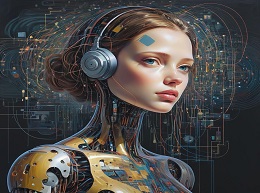Exploring AI in Art: How Artists Use Machine Learning

Art has always been a reflection of human creativity and innovation, constantly evolving with the times. In recent years, the integration of Artificial Intelligence (AI) and machine learning into the artistic process has sparked a new wave of creativity, challenging traditional notions of art and pushing the boundaries of what is possible.
The Intersection of Art and Technology
Artificial Intelligence, particularly machine learning algorithms, offers artists a new palette of tools and techniques to explore and experiment with. From generating original artworks to enhancing traditional artistic processes, AI is revolutionizing the art world in unprecedented ways.
Example: StyleGAN
StyleGAN, a machine learning model developed by NVIDIA, generates hyper-realistic images by learning the visual style of a dataset and generating new images based on that style. Artists use StyleGAN to create unique and surreal artworks that blur the line between reality and imagination.
Generative Art: The Role of AI
Generative art, a genre of art that involves creating artworks using algorithms and computer code, has seen a resurgence with the advent of AI. Machine learning algorithms can generate endless variations of images, music, and even poetry, inspiring artists to explore new creative frontiers.
Example: DeepDream
Google's DeepDream algorithm uses deep neural networks to generate hallucinogenic images by amplifying and enhancing patterns in existing images. Artists manipulate these images to create surreal and dreamlike artworks that challenge perception and invite viewers to explore the depths of the subconscious.
Collaborative Creativity: Humans and AI
Rather than replacing human creativity, AI in art often serves as a collaborator or tool for artists to augment their creative process. Artists harness the capabilities of machine learning algorithms to experiment with new ideas, iterate on existing artworks, and explore unconventional artistic techniques.
Example: AICAN
AICAN, an AI artist developed by researcher Ahmed Elgammal, creates original artworks by analyzing a database of artworks spanning different styles and genres. AICAN's creations challenge traditional notions of authorship and creativity, prompting discussions about the role of AI in the art world.
Interactive Installations: Engaging Audiences
AI-powered interactive installations invite viewers to participate actively in the artistic experience, blurring the lines between creator and audience. These immersive experiences encourage viewers to explore, interact, and engage with artworks in new and meaningful ways.
Example: The Treachery of Sanctuary
"The Treachery of Sanctuary," an interactive installation by artist Chris Milk, combines motion capture technology and AI-generated visuals to create an immersive storytelling experience. Viewers' movements are transformed into abstract images projected onto a screen, inviting them to become part of the artwork's narrative.
Ethical and Philosophical Implications
As AI becomes increasingly integrated into the artistic process, questions arise about authorship, authenticity, and the nature of creativity itself. Artists and scholars grapple with the ethical implications of using AI in art, raising concerns about bias in algorithms, intellectual property rights, and the impact of automation on artistic practices.
Example: Portrait of Edmond de Belamy
The "Portrait of Edmond de Belamy," created by the art collective Obvious using a Generative Adversarial Network (GAN), sparked controversy in the art world. Critics questioned the authenticity and value of the artwork, highlighting the ethical dilemmas surrounding AI-generated art and its place in the art market.
Conclusion: The Future of AI in Art
As AI continues to evolve, its impact on the art world will only grow, presenting both challenges and opportunities for artists, audiences, and the broader creative community. By embracing AI as a tool for experimentation, collaboration, and innovation, artists can push the boundaries of artistic expression and redefine the role of technology in shaping the future of art.
In conclusion, AI in art represents a convergence of human creativity and technological innovation, offering a glimpse into the possibilities of the digital age. As artists continue to explore the creative potential of AI, the art world stands on the brink of a new era of artistic expression, where the boundaries between man and machine blur, and the imagination knows no limits.